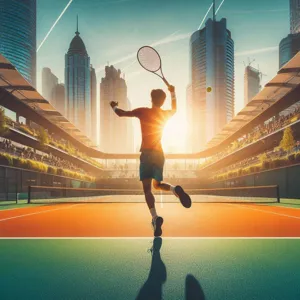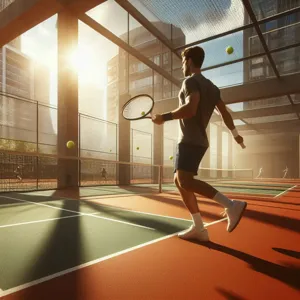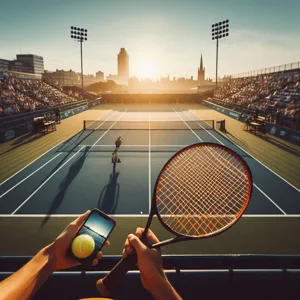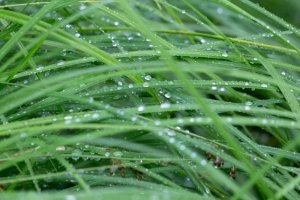Golf is often described as a game of precision and patience, with the green being the ultimate test of a player’s skill and strategy.
Mastering the art of reading greens is essential for any golfer who aspires to lower their scores and enhance their overall game. It’s not just about hitting the ball; it’s about understanding the subtle nuances of the terrain, the slope of the land, and the speed of the grass. From deciphering the grain to grasping the impact of weather conditions, the ability to read greens can make all the difference between sinking that crucial putt or watching it roll past the hole. In this blog post, we’ll explore practical tips and techniques that will help golfers of all skill levels develop a keen eye for identifying the intricacies of the green, allowing you to navigate challenges with confidence and finesse. Whether you’re a seasoned pro or a weekend warrior, these insights will elevate your game and bring you one step closer to mastering this vital aspect of golf.
1. Understanding the Importance of Reading Greens
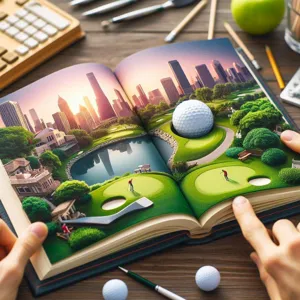
When it comes to mastering the art of putting, understanding the importance of reading greens cannot be overstated. The greens—those meticulously manicured surfaces that serve as the final destination for your golf ball—are far more than just a flat area of grass. They are dynamic landscapes, influenced by a variety of factors that can dramatically affect the ball’s path and speed. A well-read green can be the difference between sinking a crucial putt and watching your ball veer off course.
At first glance, a green may appear uniform, but the reality is much more complex. Subtle undulations, slopes, and grain can all play a pivotal role in how your ball rolls. The ability to accurately gauge these nuances requires not just experience but also a keen observational skill. For instance, a seemingly straightforward putt may actually beckon you to consider the slope’s angle, the direction of the grain, and even the weather conditions—each element can alter your approach and strategy.
Moreover, reading greens is not just about visual assessment; it’s also about intuition and feel. Developing a sense of how the ball reacts under various conditions can take time, but it’s essential for any golfer looking to improve their game. By honing your ability to read greens, you will gain greater confidence on the course, enabling you to make more informed decisions about your stance, grip, and stroke.
In essence, mastering the art of reading greens is about cultivating a deeper relationship with the game itself. It invites you to become attuned to the subtleties of your environment, transforming each putt into an opportunity for exploration and learning. As you refine this skill, you will not only enhance your performance but also deepen your appreciation for the intricacies of golf. So grab your putter, step onto the green, and start the journey toward becoming a more intuitive and successful golfer.
2. Key Factors Influencing Green Reading
Understanding the nuances that influence how a putt behaves on the green is essential for any golfer looking to sharpen their game. Several key factors play a crucial role in green reading, and mastering these can significantly improve your putting accuracy and confidence.
**Slope** is perhaps the most fundamental element to consider. Whether the green has a subtle rise or a steep decline, the slope affects how the ball will roll. A downhill putt will gain speed and break more dramatically, while an uphill putt will slow down and require more force. Observing the tilt of the green from multiple angles can provide valuable insights into how your ball will behave.
**Grain** is another critical factor that often goes overlooked. The direction in which the grass grows can either help or hinder your putt, depending on the angle at which you strike the ball. For instance, if you’re putting against the grain, expect a slower roll, while a putt with the grain will travel faster. Learning to recognize the grain pattern on different types of grass can give you a significant edge in predicting how much speed and break to apply.
**Weather conditions** also influence green reading. Wind can alter the trajectory of your putt, while moisture levels can affect the speed of the green. A wet green will slow down the ball compared to a dry one. Pay attention to the weather forecast before your round, and adjust your strategy accordingly.
Lastly, **the speed of the green** is an essential factor that varies from course to course, and even day to day. Greens can be fast or slow depending on maintenance, weather, and time of day. Familiarize yourself with the surface before you play and practice putting on similar terrains to understand how to adjust your stroke accordingly.
By carefully considering these key factors—slope, grain, weather conditions, and green speed—you’ll become more adept at reading greens, leading to lower scores and a more enjoyable round of golf. Remember, every putt is a puzzle waiting to be solved; the more you understand the pieces, the better you’ll play.
3. The Anatomy of a Golf Green

Understanding the anatomy of a golf green is crucial for mastering the art of reading greens. A well-rounded golfer knows that every green has its unique characteristics that can significantly influence the ball’s path and speed.
First, let’s delve into the surface itself—the grass. Typically, greens are covered in a finely manicured type of grass, such as Bentgrass or Bermuda, specifically chosen for its ability to provide a smooth putting surface. The height of the grass, its density, and its health all play a vital role in how the ball rolls. A well-maintained green will allow for a smooth and consistent roll, while a patchy or uneven surface can lead to unpredictable movements.
Next, consider the slope and contour of the green. Each green is designed with varying degrees of elevation and undulation, which can affect the speed and direction of your putt. When approaching a green, take the time to assess these slopes from multiple angles. Is there a subtle rise on the left side? Does the right side dip down? Understanding these contours will help you predict how the ball will react as it travels towards the hole.
Don’t forget about the fringes and collars—the areas just beyond the putting surface. The grass in these areas is often cut slightly longer, which can slow down the ball as it transitions from the green. Being aware of how this can affect your putt is essential, especially for those longer shots where precision is necessary.
Lastly, environmental factors such as wind, moisture, and sunlight can also impact the playability of the greens. For instance, a damp green may slow your putt down, while a dry, sun-baked surface could speed it up significantly. By taking these elements into account, you can develop a more intuitive understanding of how to approach each putt strategically.
Mastering the anatomy of a golf green is not just about knowing the technicalities; it’s about developing a mental map of each unique putting surface you encounter. With practice and observation, you’ll find yourself making more informed decisions, leading to improved performance on the course.
4. Analyzing Slope and Contour
### 4. Analyzing Slope and Contour
Understanding the slope and contour of the green is crucial for mastering your putting game. When you step onto the green, take a moment to survey the landscape before you. The subtle undulations and varying slopes can significantly influence the path of your ball, so it’s essential to train your eye to detect these details.
Begin by walking around the hole to get a 360-degree view of the green. Look for high and low points, noting how they might affect ball movement. A slight rise in the terrain can change the speed and direction of your putt, while a dip may create an unexpected break. Pay attention to the general slope; is it tilting toward or away from the hole? This will help you gauge how much you need to adjust your aim.
Next, examine the contour lines, which are often indicative of the green’s design. Greens with pronounced contours may have multiple slopes that can create tricky breaks. If the green is domed, the ball will tend to move toward the lower side, while a bowl-shaped green will funnel toward the center.
In addition to physical observation, trust your instincts and experience. The more you play and analyze different courses, the better you will become at reading the subtle cues of each green. Use a combination of your observations and feel to make educated guesses about the ball’s movement. Practice this skill regularly, and you’ll find that your ability to analyze slope and contour will not only improve your putting accuracy but also build your confidence on the green. Remember, every putt is a puzzle; with careful analysis, you can become a master at solving it!
5. Evaluating Grass Types and Conditions
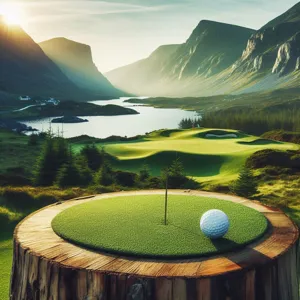
When it comes to mastering the art of reading greens, understanding the types of grass and their current conditions is paramount. Different varieties of grass can significantly impact how the ball rolls, influencing your putt’s speed and direction. Common grass types such as Bermuda, Bentgrass, and Poa Annua each have unique characteristics that can affect your game.
Bermuda grass, favored in warmer climates, tends to grow dense and can produce a smoother putting surface. However, it also has a tendency to be grainy, which means you’ll need to account for the direction the grass grows when lining up your putt. On the other hand, Bentgrass is often found on cooler-weather courses and is renowned for its fine texture and consistent speed. It holds a bit of moisture, making it crucial to gauge the day’s weather conditions before teeing off, as this will impact how the ball behaves on the green.
Furthermore, the condition of the grass plays a vital role in your putting strategy. Newly mowed greens can be faster due to the shorter blades, while longer grass may slow your ball down. Factors such as foot traffic, shade from trees, and recent weather patterns can also affect the firmness and speed of the surface. For instance, a green that has been baked under the sun may be hard and fast, while a recently watered green might feel softer and require a more delicate touch.
To evaluate these conditions effectively, take a moment to observe your surroundings as you approach the green. Look for signs of wear, the direction of the grain, and any areas that might be prone to moisture or drying out. As you practice the art of reading greens, honing in on these details will enhance your ability to judge your putts accurately, giving you the confidence to sink more balls and lower your score. Remember, a keen eye for grass types and conditions can be the difference between a solid round and a frustrating day on the course.
6. The Role of Speed in Green Reading
Understanding the role of speed in green reading is crucial for any golfer looking to improve their putting game. When approaching a putt, it’s not just about the line you choose; speed can dramatically influence the ball’s path and the likelihood of sinking your shot. The speed of the greens can vary depending on several factors, including recent weather conditions, the type of grass, and how well the greens have been maintained.
To master this aspect, golfers should spend time observing and gauging the speed of the greens before making their putts. One effective technique is to take practice strokes—mimicking the motion of your putt without actually striking the ball—to get a feel for how hard you need to hit the ball. Pay attention to how your practice strokes roll; this will give you a good sense of how fast the ball needs to travel to reach the hole.
Additionally, remember that downhill putts will require a lighter touch, while uphill putts will need a firmer stroke. The angle of the green also plays a significant role; an uphill putt may seem straightforward but can be deceptively slow, while a downhill putt can zip past the hole if you’re not cautious.
Wind conditions can further complicate matters, as even a light breeze can alter the speed of your putt. The key is to continually assess each situation: take a moment to walk around the hole, observe how the grass lies, and watch how the ball rolls on practice putts.
By honing your awareness of how speed interacts with your line and reading of the greens, you’ll find that your confidence grows, and your ability to sink those tricky putts will improve dramatically. Understanding speed is a game-changer in the world of putting, allowing golfers of all levels to navigate the greens with finesse and precision.
7. Techniques for Reading Breaks and Bumps
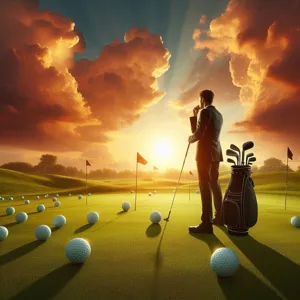
Mastering the art of reading greens isn’t just about understanding the slope; it’s about recognizing the intricate details that can make or break your putt. When it comes to evaluating breaks and bumps, a golfer’s keen observation skills are paramount. Here are some techniques to help you hone this critical aspect of your game.
First, take a moment to observe the overall slope of the green from various angles. Position yourself behind the ball and look toward the hole, then walk around to the side of the green. Different perspectives can reveal subtle breaks that may not be immediately apparent from a single viewpoint. Pay close attention to the contours and undulations—these natural features can significantly influence the path of your ball.
Next, consider the grain of the grass. The direction in which the grass blades grow can impact the speed and break of your putt. On bermudagrass, for instance, the ball will generally roll more slowly into the grain and faster with the grain. A quick evaluation of the overall grass growth direction can provide valuable insight into how your putt will behave.
Additionally, look for any subtle imperfections on the green’s surface. Bumps, divots, or even dew can alter the ball’s trajectory. Take the time to inspect the area around the hole for any irregularities that could affect your putt. If you notice a bump or a slight imperfection, adjust your stance and aim accordingly to compensate for these nuances.
Finally, practice is essential. Spend time on the practice green, experimenting with different slopes and bumps. Use a variety of balls and techniques to develop a feel for how breaks and bumps impact your putting. The more you familiarize yourself with these elements, the more instinctive your reading will become during a round.
By incorporating these techniques into your routine, you’ll develop a sharper eye for reading greens, allowing you to navigate the complexities of breaks and bumps with confidence. In the end, mastering these elements of the game can elevate your putting performance and lower your score, turning those frustrating three-putts into seamless birdie opportunities.
8. Using Your Eyes and Feet: Sensory Tips
When it comes to mastering the art of reading greens, your body is an invaluable tool, particularly your eyes and feet. Utilizing these sensory tips can significantly enhance your ability to gauge the slope, speed, and texture of the green, ultimately improving your putting accuracy.
### Using Your Eyes
Start with your eyes—observe the green from various angles. Stand behind your ball and take in the lay of the land. Look for subtle breaks and contours that may not be immediately apparent when you’re standing directly over the ball. Pay attention to the color and texture of the grass; different grass types can affect how the ball rolls. A darker patch might indicate a dip, while lighter areas could suggest a rise.
Also, scan for any imperfections or footprints that could influence the ball’s path. As you walk around the green, keep an eye on the way the grass lays and how it might affect your putt. This visual assessment will help you develop a clearer picture of where the ball is likely to go.
### Relying on Your Feet
Next, engage your feet. The ground beneath you can provide crucial information about the slope of the green. As you approach your putt, take a moment to feel the incline through your shoes. Shift your weight gently from side to side to sense the direction the green slopes.
Walking along the line of your putt can also help; notice how your feet feel on the surface. A flat area underfoot usually indicates a straight shot, while a downhill slope will feel different. This tactile feedback can guide you in adjusting your aim and stroke.
By combining these sensory insights, you’ll not only improve your ability to read greens but also develop a more intuitive understanding of how various factors influence your putt. With practice, using your eyes and feet will become second nature, transforming your green-reading skills and enhancing your overall performance on the course.
9. The Impact of Weather on Green Conditions
Weather plays a pivotal role in the condition of golf greens, and understanding its effects is essential for any golfer looking to master their game. The influence of temperature, humidity, wind, and precipitation can dramatically alter the way the ball reacts on the green, making it crucial to assess these factors before every putt.
When temperatures rise, greens tend to dry out, leading to faster speeds and firmer surfaces. This can create a challenge, as a putt that might have rolled smoothly in cooler conditions may now require a lighter touch. Conversely, cooler, wetter weather can soften the greens, making them slower and more receptive. Here, golfers must adjust their stroke, applying more power to ensure their ball reaches the hole.
Humidity also plays a key role; high humidity can lead to dew on the grass, creating an additional layer of friction that can impact ball speed. Wind, too, shouldn’t be underestimated. Even a light breeze can affect the trajectory of a putt, especially on longer distances. It can also influence the roll of the ball as it encounters uneven surfaces or breaks.
Moreover, recent rain can cause greens to swell and become bumpy, disrupting a smooth roll. In contrast, dry spells can lead to hard, cracked surfaces, making it essential for golfers to be extra vigilant.
By staying attuned to the weather and its influence on green conditions, golfers can make more informed decisions on their approach, adjusting their strategies based on the day’s unique circumstances. This awareness can mean the difference between a simple tap-in and a frustrating three-putt, ultimately refining your skills and enhancing your overall performance on the course.
10. Practicing Your Green Reading Skills
**10. Practicing Your Green Reading Skills**
Mastering the art of reading greens is not solely about understanding the physics of a putt; it’s also about developing a keen eye for the subtleties that can make or break your game. Just as an artist perfects their craft through practice, so too must a golfer hone their green reading skills to achieve consistency and confidence on the course.
Start by dedicating time during your practice sessions specifically to green reading. Find a putting green with a variety of slopes and undulations, and take the opportunity to study how the ball behaves on different surfaces. Observe how the grain of the grass affects the roll of the ball. Is the grass lush and thick, pulling the ball to one side, or is it dry and sparse, causing it to roll true? These small details can significantly influence your putts.
To elevate your practice, use alignment aids like a string line or chalk to visualize the path your ball should take. Experiment with different angles, distances, and speeds, noting how each variable impacts the ball’s trajectory. You can also practice with a partner, taking turns reading each other’s putts. This not only gives you a fresh perspective but also encourages discussion about what you see and how you interpret the green, fostering a deeper understanding of the nuances involved.
In addition to on-course practice, consider incorporating technology into your training regime. Many golf apps and devices now offer advanced analytics on putting, allowing you to track your performance over time, analyze your strokes, and adjust your approach accordingly.
Finally, don’t underestimate the power of visualization. Spend a few minutes before your round or during downtime on the course to mentally walk through the greens you will be playing. Visualizing the breaks and slopes can enhance your memory and decision-making when it’s time to putt.
By consistently dedicating time to practice your green reading skills, you’ll develop an intuitive sense of how to assess each putt, ultimately making you a more effective and confident golfer. Remember, every putt tells a story; it’s your job to read it clearly.
11. Tools and Technology to Aid Green Reading
In the ever-evolving world of golf, technology has become an invaluable ally for players seeking to improve their game, especially when it comes to mastering the art of reading greens. With an array of tools at your disposal, you can enhance your understanding of the green’s contours, slopes, and speeds, allowing you to make more informed decisions on the course.
One of the most popular tools among golfers is the **green reading books**. These pocket-sized guides provide detailed layouts of various courses, highlighting the slopes and break of the greens. They often feature notations on where to aim your putts and the ideal lines to take, making them an essential companion for any golfer who wants to improve their accuracy.
**Mobile apps** have also gained traction, offering advanced features like augmented reality to visualize the green’s contours in real-time. Apps like “Golfshot” or “Arccos” allow you to track your performance while providing feedback on your putting statistics. These insights can highlight patterns in your game, helping you to adjust your approach to reading greens.
Another innovative tool is the **putting alignment aids**. These devices help you practice your aim and stroke, ensuring that you’re aligned correctly when addressing the ball. By gaining a better understanding of how your body and putting mechanics interact with the green’s slope, you can improve both your confidence and your performance.
Finally, investing in a **putting simulator** can take your practice to the next level. These high-tech setups mimic various green conditions and allow you to experiment with different putts in a controlled environment. By honing your skills on a simulator, you’ll be better prepared to face the nuances of real-life greens.
Incorporating these tools and technologies into your practice routine can significantly enhance your ability to read greens, leading to lower scores and greater enjoyment of the game. As you embrace these advancements, remember that while technology is a great aid, nothing replaces the value of experience and intuition honed through countless rounds on the course.
12. Learning from Pros: Case Studies and Techniques
When it comes to mastering the art of reading greens, few resources are as invaluable as the techniques employed by professional golfers. These players have spent years honing their skills, studying the subtleties of putting surfaces, and perfecting their approach to deciphering the often intricate nuances of each green. By examining case studies of successful putts made by the pros, you can gain insights that will elevate your own game.
Take, for instance, the legendary putting prowess of Jack Nicklaus, whose meticulous pre-putt routine included evaluating the slope and grain of the grass in minute detail. Nicklaus often emphasized the importance of visualizing the ball’s path before making a stroke. He would take a few steps behind the ball, squinting slightly to analyze the slope from different angles, a technique that can benefit golfers of all skill levels. Implementing this practice can help you develop a more intuitive understanding of how the ball will react when it meets the green.
Similarly, studying the approach of players like Justin Thomas, who is known for his aggressive yet calculated putting style, can provide inspiration and practical techniques. Thomas often uses a system of markings on his glove to remind himself of key points to consider: the break, the speed of the green, and even atmospheric conditions. By adopting a personalized technique for note-taking—be it mental reminders or physical markers—you can reinforce your understanding and execution of various putting scenarios.
Additionally, consider the case of Annika Sörenstam, a player who mastered the art of reading greens through extensive practice and visualization. Sörenstam would often practice on greens that mimicked the layout of the courses she would compete on, allowing her to familiarize herself with different types of breaks and speeds. This dedication to practice is a reminder that consistent and deliberate training can significantly enhance your ability to read greens.
By learning from these professionals and integrating their techniques into your own practice routine, you can develop a sharper eye for reading greens, leading to more confident and successful putts on the course. Embrace the insights offered by these case studies, and remember that every putt is an opportunity to refine your skills and deepen your understanding of this critical aspect of the game.
13. Developing a Pre-Putt Routine
A well-crafted pre-putt routine can be the secret sauce that elevates your putting game from mediocre to masterful. It’s not just about the physical act of putting; it’s about creating a mental framework that primes you for success on the green. Your routine should be as unique as your swing, tailored to your personal style, but effective enough to bring consistency and focus to every putt.
Start by establishing a calm and focused mindset. Before stepping up to the ball, take a moment to breathe deeply and visualize the path the ball will take. This mental imagery can help reinforce your confidence and sharpen your concentration.
Next, consider your setup. Many golfers find it beneficial to incorporate a series of physical cues that signal readiness. Perhaps it’s a specific grip adjustment, a tap of the putter on the ground, or a quick check of your alignment. These consistent movements not only prepare your body but also signal your brain that it’s time to focus on the task at hand.
As you approach the ball, take a moment to survey the green. Assess the slope, the grain of the grass, and any subtle breaks that may influence your putt. Engaging with the surface in this way can deepen your understanding of its nuances, leading to better decision-making.
Finally, commit to your read and trust in your routine. Once you’ve gone through your steps, eliminate any lingering doubts and putt with conviction. The more you refine your pre-putt routine, the more natural it will become, allowing you to replicate the same successful process time and again. With a solid routine in place, you’ll not only enhance your focus and consistency but also enjoy the mental clarity that comes from knowing you’re prepared for every challenge the green throws your way.
14. Common Mistakes in Green Reading and How to Avoid Them
When it comes to mastering the art of reading greens, even seasoned golfers can fall victim to a few common pitfalls that can throw off their game. Understanding these mistakes is key to sharpening your skills and making more accurate putts.
One prevalent mistake is relying too heavily on instinct rather than taking the time to assess the green thoroughly. Many players make a quick glance and assume they can gauge the slope and speed without scrutinizing the surface. This often leads to misreads and miss-hits. To avoid this, take a systematic approach: walk around the hole, observe the contours, and visualize how the ball will travel, both uphill and downhill.
Another common error is neglecting to consider the grain of the grass. Golfers often overlook how the direction of the blades can affect the ball’s roll. A green with a grain that grows toward the hole might resist the ball, while one that grows away can speed it up. Always take a moment to assess the grain by looking at the grass closely; a subtle sheen can indicate the direction it’s growing.
Additionally, many golfers fail to factor in the environmental conditions, such as wind and moisture. Wind can subtly alter the path of your putt, especially on longer greens, while wet conditions can slow the ball down considerably. Always consider these external factors before committing to your shot.
Lastly, relying too much on past experiences can be a double-edged sword. While familiarity with a course can be beneficial, each round can present different conditions. Fresh insights for each hole can make a world of difference, so treat every putt as a unique challenge.
By recognizing and avoiding these common mistakes, you can enhance your green reading skills and, ultimately, your overall performance on the course. Remember, patience and practice are essential to mastering the nuances of the greens, so don’t rush the process—take the time to truly see what’s in front of you. Happy putting!
15. Putting it All Together: Strategies for Different Courses
When it comes to mastering the art of reading greens, one of the most crucial skills a golfer can develop is the ability to adapt their strategy to different courses. Each course has its unique layout, green speed, and undulation, which can significantly influence how a putt behaves. To put it all together, golfers must consider various factors that affect their putting game.
First, familiarize yourself with the course before your round. Spend some time on the practice green, where you can assess the speed and texture of the grass. Is it a smooth bentgrass or a more textured Bermuda? Understanding the type of grass can give you insights into how the ball will roll. Pay attention to the slope of the greens as well; use your eyes to identify any significant breaks and undulations that could affect your putt. When you’re on the green, take note of the overall layout—look for high and low points and how they might influence the water drainage, which can cause subtle changes in speed.
Next, consider the weather conditions. Wind can impact the ball’s trajectory, and humidity can cause greens to be slower or faster than usual. Adjust your strategy based on these conditions—make sure you’re giving sufficient break to a putt if the greens are particularly fast, or perhaps be more aggressive with your stroke when they are softer and slower.
Another critical element is to observe how your playing partners are navigating the greens. Watching their putts can provide valuable information about the subtle breaks you may have missed. Don’t hesitate to communicate and ask for their insights; often, a fresh perspective can make all the difference in how you approach your putt.
Finally, keep a mental notebook of how different courses and greens behave. Over time, patterns will emerge, and your understanding of how to read various greens will deepen. With practice and attention to detail, you’ll find that you can confidently adapt and refine your putting strategies, improving your performance regardless of where you play. By mastering these strategies for different courses, you’ll not only enhance your skills but also enjoy the game of golf even more as you see your scores drop.
In conclusion, mastering the art of reading greens is a vital skill that can elevate your golf game to new heights. By employing the tips we’ve shared—from understanding the nuances of slope and grain to practicing visualization and distance control—you can develop a more intuitive feel for the greens. Remember, every golfer, regardless of skill level, can benefit from honing this crucial aspect of the game. So, the next time you step onto the course, take a moment to assess the greens thoughtfully; your improved putting performance will surely follow. Embrace the challenge, enjoy the process, and watch as your confidence grows with every successful putt. Here’s to lower scores and more enjoyable rounds ahead!





